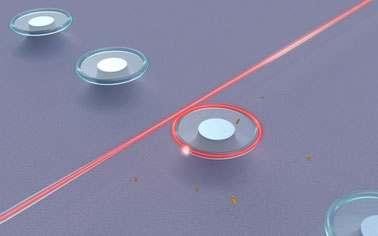| Posted: Mar 07, 2016 |
Novel whispering-gallery-type sensor for single nanoparticle detection
(Nanowerk News) Ultrasensitive detection of nanoscale particles has applications in important fields ranges from environmental monitoring to analysis of viral structures. However, it remains extremely difficult due to ultralow polarizabilities of small-sized, low-index particles.
|
|
A team led by Professor Xiao Yun-Feng at Peking University, collaborated with Yonsei University of Republic of Korea, demonstrated experimentally that the dissipative interaction in a high-Q optical microcavity allows the detection of single nanoparticles.
|
|
This work has been published in the recent issue of Physical Review Applied ("Detection of Single Nanoparticles Using the Dissipative Interaction in a High-Q Microcavity").
|
 |
| Schematic drawing of on-chip microcavity sensors.The probelaser light is coupled into the whisperinggallery microcavity via a fiber taper. The cavity modes can be characterized by the transmission spectrum, shown as a resonance dip. When a single nanoparticle binds to the surface of the microcavity, the linewidth change of the cavity and the mode shift are simultaneously measured, representing the dissipative and reactive sensing method, respectively.
|
|
Over the past few years, high-Q optical microcavities have shown great potential in sensing applications due to the strongly enhanced light-matter interaction therein. The conventional sensing mechanism, however, has to rely on the reactive interaction.The reactive sensing is limited by the polarizability of the particle, and will fail its sensing function when the real part of the polarizability approaches zero. In the publication, the authors pointed out that the dissipative interaction opens a channel of the cavity mode decay and results in the resonance linewidth change, which forms an effective sensing scheme even when the real part of analyte polarizability approaches zero, because the signal magnitude is determined by the absorption loss and side scattering of the particle.
|
|
In the experiment, detection of single gold nanorodsis used to assess the sensing performance.“The gold nanorod of the size of 40 nm×16 nm is a perfect candidate to test the microcavity sensor for two reasons. One is that the polarizability of this nanoparticle can be tuned by varying the probe wavelength. The other is that the surface plasmon resonance of the particle of this dimension coincides with one of our probe wavelengths in the experiment, at which the real part of the polarizability become zero, most likely invalidating the reactive sensing method, but strengthening the dissipative one,” said Dr. YanyanZhi, the post-doctor and one of the co-first authors of this work.
|
|
The researchers examined experimentally both the reactive and dissipative sensing methods, by monitoring the mode shift and the linewidth change of the high-Q cavity resonance, respectively. It is found that the reactive sensing signal cannot be recognized from the noises when the probe wavelength is on plasmonic resonance where the nanorod polarizability approaches zero, while the proposed dissipative sensing method still works well, which is consistent with the theoretical predictions.The anticipated detection limit can reach 13 nm×5 nm, which is about 12 times smaller volume than that can be detected by the reactive sensing method.
|
|
This dissipative sensing method not only provides a new physical mechanism of microcavity sensing, but also represents a significant step towards practical optical sensors in areas of analytical chemistry, environmental science, and molecular biology.
|
|
“Practically, it’s ready that both the mode shift and the linewidth change of the cavity mode can be simultaneously measured, and thus the common reactive and the proposed dissipative sensing methods are compatible to each other,” said Prof. Xiao, “The combination of those two sensing methods adds new dimensions to what can be measured using each of the two methods alone. The dissipative sensing method using a high-Q microcavityoffers a great platform for the detection of tiny single particles, such as vital virus, particles in the polluted air, lossy particles in the manufacturing process, and other nanoparticles under interest.”
|

